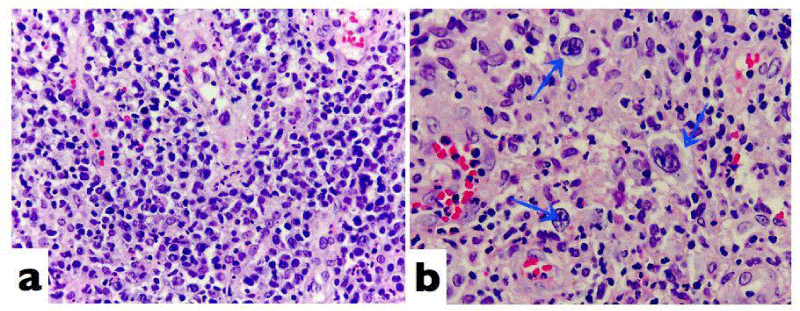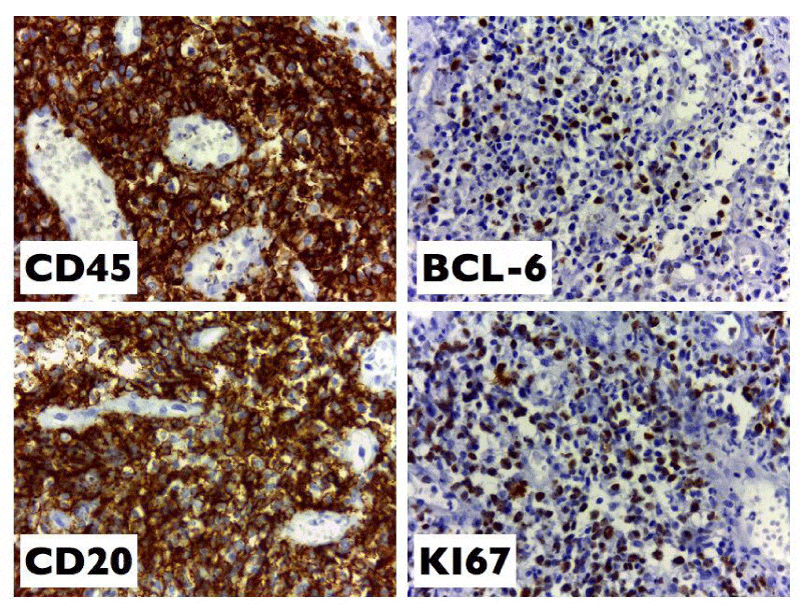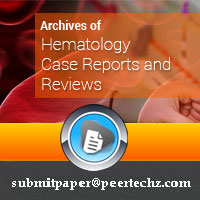Archives of Hematology Case Reports and Reviews
Diffuse Large B-Cell Lymphoma and Classical Hodgkin´S Lymphoma Converge in an Unusual Presentation as a Gastric Composite Lymphoma: Case Report
Patricia Ramos1, Fernanda Díaz-Sámano2 and Enoe Quiñonez1*
2La Salle University of Medicine. Calle Benjamín Franklin 47, Cuauhtémoc, Hippodrome Condesa, 06140 Mexico
Cite this as
Ramos P, Díaz-Sámano F, Quiñonez E (2016) Diffuse Large B-Cell Lymphoma and Classical Hodgkin´S Lymphoma Converge in an Unusual Presentation as a Gastric Composite Lymphoma: Case Report. Arch Hematol Case Rep Rev 1(1): 001-002. DOI: 10.17352/ahcrr.000001An 88-year-old male, with a history of diffuse abdominal discomfort and weight loss that presented a composite gastric lymphoma (CGL) expressing CD20, BCL-6 and a high cell proliferation index in diffuse large B-cell lymphoma and positive to CD30 and C15 in typical Reed-Stemberg cells forming a Classical Hodgkin´s lymphoma. Composite lymphoma represents <5% of the occurrence of lymphoma with a poor prognosis, which were corroborated and demonstrated with a characteristic immunophenotype.
Background
Composite lymphoma defined as the coexistence of two or more morphologically and phenotypically distinct lymphoma types in a single anatomic organ or tissue [1].The causes are unknown but several theories have been proposed, including clonal selection with additional mutational accumulation, genomic instability and an evidence with viral factor mostly by Epstein Barr Virus [1-3].
The reported incidence is less than 5% [2] . Composite gastric lymphoma (CGL) is a very rare occurrence with 0.025% and to date only three previous cases have been reported in the literature [1].
Case Presentation
An 88-years-old male, without previous history of importance, presented eating disorder, diffuse abdominal discomfort with epigastric pain after feeding and weight loss of 10 kilograms, two months before being diagnosed with, a computerized tomography scan revealed a gross wall in gastric fundus, without lymphadenopathy. Endoscopy was performed and revealed an irregular infiltrating lesion in gastric body and fundus. The patient unfortunately declined any further oncology treatment, 6 months after initial diagnosis the patient was still alive with progressive tumor.
Results
Histologically samples with hematoxylin and eosin showed a diffuse population of two neoplastic lymphocytes cells. The first ones were characterized as a diffuse and large infiltrating lymphocytes that affects the lamina propia without harming the gastric fundus glands (Figure 1a).
The second type of neoplastic lymphoid cells identified were characterized by the classic Reed-Stemberg cells with abundant eosinophilic cytoplasm and two nuclear lobes with prominent nucleoli in a rich inflammatory background in gastric mucosa (Figure 1b).
Discussion
This unusual entity exhibit a characteristic immunophenotype that represents the two population cells in the same organ. Four cases, including the present case, have been reported in the literature with gastric localization (Table 1). But there are seven more cases reported as a composite lymphoma in other anatomical localizations one of them in small intestine and colon [3,4] and one case with GCL reported with no evidence of disease in a 67 year-old-man [5].
In the present case immunohistochemistry confirmed the presence of the two lymphoma population. Expressed CD45, CD20, BCL-2, BCL-6 and Ki67 was found in approximately 70% that represented the characteristic immunophenotype as a diffuse large B-cell lymphoma (Figure 2) in the other hand we demonstrated the co-existence of a classical Hodgkin´s lymphoma with the presence of Reed-Stemberg cells that were positive to CD30, CD15 and with reactive background showed positive to CD45 (Figure 3).
The main differential morphological diagnosis is the Gray zone lymphoma with intermediate features, characterized by pleomorphic tumor cells with “sheet-like” pattern and a typically immunophenotype exhibiting a transitional features with CD45, CD30, CD15 and CD20 positive in almost all cells [6]. The results of the present report highlight the importance of using immunohistochemistry for the differential diagnosis. Since the composite lymphoma demonstrated the existence of two different lymphoid populations in the same organ without transitional features.
Conclusion
GCL has been reported in isolated cases that represent a very rare entity that the occurrence may be underestimated. For this reason it is required a multidisciplinary approach with immunohistochemistry complementary studies, in order to detect the presence of two lymphomas in the same anatomic localization.
Consent
Written informed consent was obtained from the patient for publication of this Short Report and any accompanying images. A copy of the written consent is available for review by the Editor-in-Chief of this journal.
- Wang HW, Yang W, Wang L, Lu YL, Lu JY (2013) Composite diffuse large B-cell lymphoma and classical Hodgkin´s lymphoma of the stomach: Case report and literature review. World J Gastroenterol 19: 6304-6309. Link: https://goo.gl/mimm8b
- Thirumala S, Esposito M, Fuchs A (2000) An unusual variant of composite lymphoma: a short case report and review of the literature. Arch Pathol Lab Med 24: 1376-1378. Link: https://goo.gl/xdSCMj
- Huang Q, Wilczynski SP, Chang KL, Weiss LM (2006) Composite Recurrent Hodgkin Lymphoma and Diffuse Large B-Cell Lymphoma. American J Clin Pathol 126: 222-229. Link: https://goo.gl/bxWuxB
- Asharafi F, Kowsari F, Darakhshandeh A, Adibi P (2014) Composite lymphoma in a patient with ulcerative colitis: A case report. Int J Hematol Oncol Stem Cell Res 8: 45-48. Link: https://goo.gl/OW0IBU
- Prochorec-Sobieszek M, Majewski M, Sikorska A, Kos K, Huszcza S, et al. (2006) Localized gastric diffuse large B-cell lymphoma and Hodgkin´s lymphoma as a secondary neoplasms in two patients with chronic lymphocytic leukemia. Leuk Lymphma 47: 2244-2246. Link: https://goo.gl/KCa2pS
- Jaffe ES, Stein H, Swerdlow SH, Campo E, Pileri SA, Harris NL (2008) WHO Classification of Tumours of Haematopoietic and Lymphoid Tissues. 4th Edition. Lyon 267. Link: https://goo.gl/wD6xx3
Article Alerts
Subscribe to our articles alerts and stay tuned.
 This work is licensed under a Creative Commons Attribution 4.0 International License.
This work is licensed under a Creative Commons Attribution 4.0 International License.




 Save to Mendeley
Save to Mendeley
